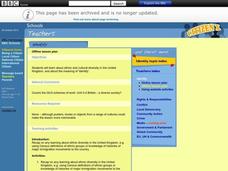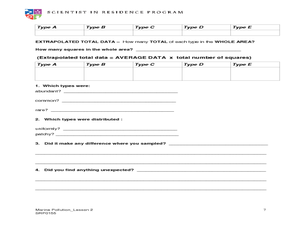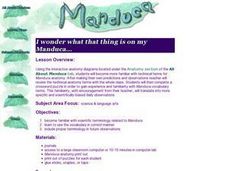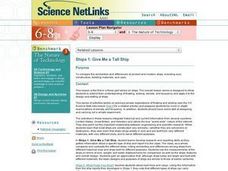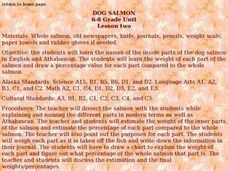BBC
Identity
Ethnic diversity is the focus of the political science lesson presented here. In it, pupils discuss the variety of ethnicities they see at their own school. They share their knowledge, or personal experiences of the way that people of...
Curated OER
Reading Trees: Understanding Dendrochronology
Students examine tree-ring dating and discuss the lack of water the settlers in Jamestown faced. They create paper tree rings, simulate rain patterns, and describe the history of construction paper tree sequences.
Curated OER
Scientific Sampling
Students take a sample of fish and try to determine how many fish are in the sea. In this scientific sampling lesson, students explore the way scientists measure large areas of samples. Students record the distribution in a quadrant.
Curated OER
Rotocopters
Students construct their own rotocopters to study flight. In this flight lesson students work in groups and complete timed trials of their rotocopters.
Curated OER
Dissecting Owl Pellets
Students dissect owl pellets. In this dissecting owl pellets lesson, students discuss birds of prey and make predictions about what they may find during the investigation. Students tease out skull and bones and try to make a complete...
Curated OER
SEVERE WEATHER UNIT
Learners conduct research on specific severe weather patterns of interest and collect data to be shared with other students on these phenomona. They write (or review) a severe weather action plan for the school and presents their findings.
Curated OER
I Wonder What That Thing Is On My Manduca
Pupils use the internet to gather more information on the anatomy of the Manduca. They make predictions of what the insect will look like when it hatches and complete a crossword puzzle to practice their vocabulary. They continue to make...
Curated OER
Color My World
Second graders experiment mixing primary colors to form other colors using frosting.
Curated OER
All About Me: My Senses
Students describe the basic senses and then use their senses to describe what they learned.
Curated OER
Human Fingerprints: No Two The Same
Students will be offered numerous opportunities to further enhance their observational skills as well as the integration of math with their continual exposure to the metric system, measurement, and graphing to represent their data....
Curated OER
Are You What You Eat?
Young scholars observe what happens to the pigment of the Manduca when food coloring is added to their diet. They discuss how coloration affects their lifestyle. They answer questions to complete the lesson.
Curated OER
Making Pretzels
Students explore how people use plants for food. They use pretzels to see how wheat can be turned into food.
Curated OER
LESSON #2 SAFETY UNIT: Real-life reading selection
When studying pollution and the environment, you can use this activity as an enrichment. Safety-conscious learners read a 2005 article about an ammonia leak from a Kentucky fast-food product plant. They work in small groups to discuss...
Curated OER
A Pressing Project
Students create a collection of pressed plants. In this plant lesson, students use newspaper, plywood, and a rubberband to press plants they previously collected.
Curated OER
Fun Bones
Use the hokey pokey music to teach the names of some of the major bones in the human body. Circle up, put on the music, and put your right radius in. Use this in an anatomy class to spice things up a bit!
Curated OER
Give Me a Tall Ship
Sixth graders develop an understanding of floating, sinking, density, and buoyancy and apply it to the design of testing of ships.
Curated OER
The Heart of the Matter
Upper elementary pupils learn about the blood transportation system and anatomy of the human heart. They fill in an outline of the human heart (not included) focusing on the flow of blood to and from the heart. Using stethoscopes,...
Curated OER
Living vs. Non-living
Students go on a nature walk and observe and discuss the living and non living things they see in the ecosystem. In this living and non living lesson plan, students complete a connecting string activity to simulate an ecosystem.
Curated OER
On the Trail of the Hudson's Migratory Fish
Using data related to the fish in the Hudson River area, learners calculate distance, elapsed time, and growth. They learn about migratory fish, the life cycle of a fish, analyze a map, and answer questions.
Biology Corner
Cell Theory Rap
All that this will link you to is a rap about cell theory and organelles. Use it as an example for a creative assignment in your biology class. Divide the class into groups and assign them a topic for which they write and perform a skit,...
Curated OER
Air Quality Issues
Students identify the different layers of the atmosphere. They examine the different types of air pollutants. They also discover laws in effect that work to protect the environment.
Curated OER
Metamorphosis Magic
Students make different motions for each stage in the butterfly life cycle and plant a garden. In this butterfly life cycle lesson plan, students can take the mini gardens home and discuss how butterflies help gardens.
Mathematics Vision Project
Quadratic Equations
Through a variety of physical and theoretical situations, learners are led through the development of some of the deepest concepts in high school mathematics. Complex numbers, the fundamental theorem of algebra and rational exponents...
Curated OER
Dog Salmon Lesson Two
Learners identify the inside parts of a dog salmon in English and Athabascan. They weigh each part of the salmon and determine the percentage of the whole that the part represents.
